ST PANCRAS STATION – EUROPEAN GATEWAY
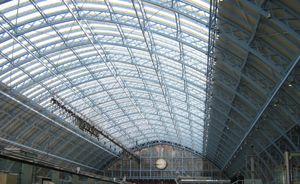
St Pancras roof
This station is important because here is where to depart and arrive with Eurostar - the train that moves through the Channel Tunnel under the English Channel to Europe.
St Pancras Station at King’s Cross was opened in 1868 and is one of the wonders of Victorian engineering. Along with the former Midland Grand Hotel, it is a masterpiece of Victorian Gothic Architecture and one of the most elegant stations in the World. It has in recent years been refurbished to accommodate international train services its history is a remarkable tale of decay, restoration and spectacular rebirth.
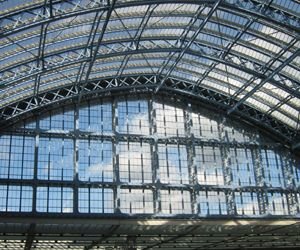
St Pancras to trains
I saw the newly renovated station just before it reopened, as I was working with Transport for London and went on a special visit to see the finished product. I still go to St Pancras station now and then to meet a friend or two. A great deal of work went into the renovation and the end result was stunning and much effort had gone into rebuilding in the same brickwork and ironwork that already existed in the old building.
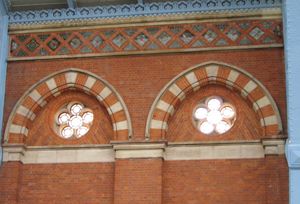
Wall detail
St Pancras was transformed to become the new arrival point for Eurostar services, and now the surrounding area has become one of London’s newest destinations. The platform deck was raised up on a grid of 688 cast-iron columns in order to allow steam engines to pass over the Regent’s canal just to the north. The space underneath, now called the Arcade, was designed and used to store beer produced by Burton Brewers, notably Bass and Thomas Salt.
The roof is made up of a series of wrought iron ribs resulting in a space 100ft high, 240ft wide and 700ft long. It was the largest single spanned roof in the world when first built, and its design was copied across the world, including at Grand Central Station in New York. The roof trusses form a pointed arch which was complemented beautifully by the architecture of the hotel.
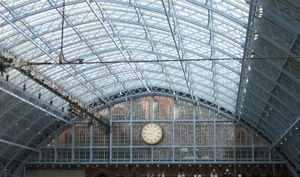
St Pancras Clock
In the 19th century St Pancras was one of the most important gateways into London. On opening it provided services to Manchester, Liverpool, Leeds and Bradford and from 1876 the station offered services all the way up to Edinburgh. In June 1874 the first Pullman service in the UK with restaurant car and sleeping accommodation, left the station, running initially to Bedford and by 1878 all the way to Wick at the northern tip of Scotland. This was the first time ever that meals were served to passengers on a train.
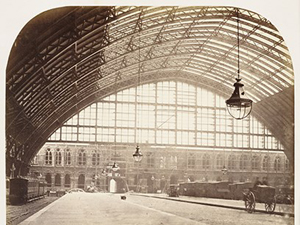
Original roof
Throughout its history freight traffic was very important particularly goods and minerals. In 1862 the Midland Railway brought in 800,000 tons of coal, nearly 18% of the Capital’s total consumption. In addition to this, once St Pancras was built, three beer trains a day from Burton on Trent came into the station with more in the brewing season. The wagons were lowered from platform level by hydraulic lift, on to tracks and through an ‘ale run’ into the main storage area of the undercroft. Other commodities brought to the capital were milk, fish and potatoes.
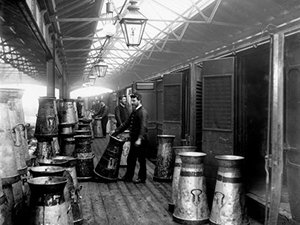
Milk Churns being moved
The herald of change for St Pancras came with the First World War. On the night of February 17th 1918 five bombs were dropped on or near the station and hotel. None of these caused any casualties, but the fifth bomb fell on the glass covered cab road beside the booking office and killed twenty people, injuring a further thirty three. This was the greatest number of casualties suffered in any air raid on a London station during the war. The train services within the station were unaffected, however the roof to the Booking Office was lost and replaced by a plainer ceiling.
The war ended with the railway system very run down and a suggestion was made by the London Society in 1921 that St Pancras be closed. This came to nothing but what did happen was that, under the Railways Act 1921 four mainline railway companies were established and the Midland Railway passed under the control of the London Midland & Scottish Company (LM&S). The Hotel, once the talk of London when it opened in 1876, declined and finally closed in 1935. It was used thereafter as offices by the LM&S.
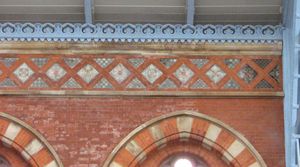
Brickwork detail
In 1966 proposals to demolish both Kings Cross and St Pancras were put forward by British Rail. However, following the public response from figures such as architectural historian Niklaus Pevsner and poet John Betjeman, (later Poet Laureate) the station was listed Grade I in November 1967.
A bright new future for the station emerged in 1993 when the Government decided to plan a high speed route for Channel Tunnel trains running from Dover to London via Stratford, and ending at St Pancras. In order to convert the station for use by modern international trains the station had to be doubled in length, and an additional 6 new platforms were needed to serve both international and domestic trains at the same time.
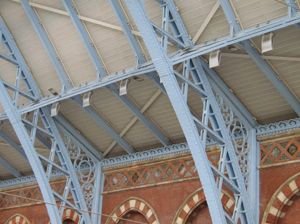
Ironwork detail
To preserve Scott and Barlow’s original design a wholly separate extension was constructed in concrete, glass and steel. Perhaps the greatest change to the historic station was the reuse of the beer storage areas for station facilities. A series of light wells were cut through the platform deck into the undercroft to create a wonderful new space from which customers can now view the roof in all its glory.
The renewal of the Station took three years, from 2004 – 2007, and followed a rigorous and painstaking and process of conservation. The original designs for the station were examined at the National Archives at Kew and the original sources of brick and stone were identified for repair work. The newly restored Station was opened by the Queen on 6th November 2007 at an opening concert performed by the Royal Philharmonic Concert Orchestra.
This is a station well used and one that welcomes visitors from Europe; Paris, Brussels, Lille, Avignon and far beyond. It takes just over two hours from St Pancras to Paris and you could take a longer journey into Europe or just plan a day trip, probably one of the most exciting rail journeys you’d take.
own images except sepia and b&w from Railway museum
Good post. It's a good thing that those that are renovating the station traced the original source of the building design and materials. It seems they want to retain its historic form, well that's classical English for you, they are good at preserving the forms of their historical artifacts and buildings. Good one
Yes and sometimes they do it perfectly and others they overdo it! But we do have our traditions so it's good they keep them going. So much gets forgotten. I'm into reviving people who should be remembered. Happy Steeming!
Wow, that's a good one. Thanks